
Courses offered
The C(L)A(S)P model adopted by the Projeto Guri was developed by the English educator Keith Swanwick, who is one of the most important names in music education today. The model is based on three main pillars to promote active engagement by students with the music, namely: composition, improvisation or arrangement; musical performance (instrumental or vocal); and musical appreciation (hearing and active listening). These activities encompass the mastering of technical skills and the written language of music and the development of students’ perception and expression, with a focus on musical fluency from the onset of the learning process.
The acronym C(L)A(S)P reflects the active music-making achieved by the combination of these activities, with the technical skills and literature enclosed between parentheses since they serve to support the main pillars: Composition, Appreciation and Performance. The principles of the C(L)A(S)P Model include the integrated execution of these activities to ensure that knowledge is actively acquired and experienced by students.
Based on this model, the Projeto Guri created the course “Fundamentals of Music” as another option for students enrolled in one of the instrument and/or choir programs offered by the Regional Education Centers. The program exposes students to the basic concepts used in active music making through educational and fun activities. In addition to Composition, Appreciation and Performance, three other terms are used: “material,” “expression” and “form.” “Material” refers to aural perception and sound control. “Expression” is the expressive nature of the sentences demonstrated by the choices of time, intensity, dynamics and coordination. “Format” is the way in which the song is organized, the relationship between sentences, repetition, contrast, variation and transformation.
Choir Singing
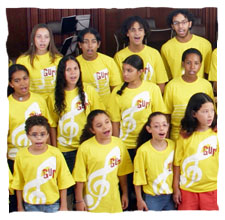
The choral is based on the Idea that everyone can participate and sing. The human voice is one of the oldest sound instruments and the practice of singing can be dated back to Egypt. A choir can have many formations: infantile, infantile-juvenile, juvenile, masculine, feminine, mixed and of the elderly. It can be classified in suites, including sopranos (high pitch feminine voices), contraltos (low feminine voices), tenors (high masculine voices) and bass (low masculine voices). After the 19th century, the choir adopted a more social characteristic, becoming a ally of musical education because it does not require material (such as instruments). The repertoire is made up of songs chosen by the group or with already existent pieces. The most important factor is the will to unite people to sing.
Plucked strings
‘Cavaquinho’
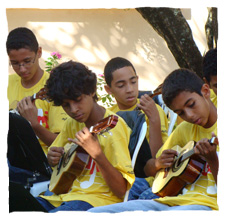 It always has been linked to folklore and popular manifestations. It comes from the Ilha da Madeira, an old Portuguese colony where it was called ‘braguinho’ or ‘machete’. ‘ Cavaco” means leftover wood, but it was made popular as cavaquinho, an affectionate way to call the instrument. Till today it is heard in popular and folklore songs, like samba, choro, forró and MPB. Its sound is high, and like the guitar, can be used in solos or along with other instruments. After the 1950’s it started to be used more as a soloist instrument. Although it is an expressive representation of the music from Cabo Verde (ex-Portuguese colony), and of Hawaii (where it is called ukulele), only in Brazil is the cavaquinho more and more present in popular music.’
It always has been linked to folklore and popular manifestations. It comes from the Ilha da Madeira, an old Portuguese colony where it was called ‘braguinho’ or ‘machete’. ‘ Cavaco” means leftover wood, but it was made popular as cavaquinho, an affectionate way to call the instrument. Till today it is heard in popular and folklore songs, like samba, choro, forró and MPB. Its sound is high, and like the guitar, can be used in solos or along with other instruments. After the 1950’s it started to be used more as a soloist instrument. Although it is an expressive representation of the music from Cabo Verde (ex-Portuguese colony), and of Hawaii (where it is called ukulele), only in Brazil is the cavaquinho more and more present in popular music.’
‘Viola caipira’
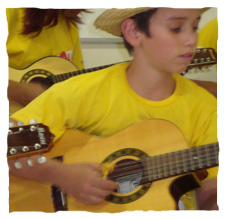 Derived from the vihuela, the viola caipira (Brazilian country guitar) was popular in the Iberian Peninsula (Region of Spain and Portugal) through the invasion of the moors. With a high and melancholic sound, it was brought to brazil by the Jesuits in the first colonizing expeditions during the second half of the 1600’s. during this time it was used in the religious teaching of music and of Portuguese folklore music to the Indians during the process of catholic evangelization. In Brazil, the cavaquinho suffered the influence of many cultures and ethnic groups, resulting in new ways to play and typical rhythms of our country, like the cururu, cateretê and the recortado. It is always used in root music and viola orchestras and currently it is also present in other musical styles, like MPB.
Derived from the vihuela, the viola caipira (Brazilian country guitar) was popular in the Iberian Peninsula (Region of Spain and Portugal) through the invasion of the moors. With a high and melancholic sound, it was brought to brazil by the Jesuits in the first colonizing expeditions during the second half of the 1600’s. during this time it was used in the religious teaching of music and of Portuguese folklore music to the Indians during the process of catholic evangelization. In Brazil, the cavaquinho suffered the influence of many cultures and ethnic groups, resulting in new ways to play and typical rhythms of our country, like the cururu, cateretê and the recortado. It is always used in root music and viola orchestras and currently it is also present in other musical styles, like MPB.
Guitar
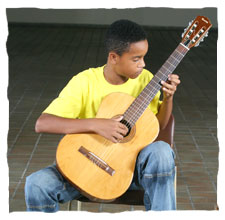 The history of guitar – one of the most widespread instruments in the world – has its beginning in the 15th century in Spain. After that, it went through many transformations until, by around 1870, it took on its current shape through the work of Antonio Torres. It is present in many musical cultures, from the most diverse forms of popular music to the concert rooms. In Brazil, because of its ease of adaptation to different genres and styles, the guitar marks its presence in songs of the field and of the city (choro, samba, pagode, MPB and jazz). It is a basic instrument for the practice of popular Brazilian music, used as a solo in bands and orchestras. Its sound is intimate, with infinite possibilities and timbres and harmonies. For those who are beginners in music, the guitar is very versatile.
The history of guitar – one of the most widespread instruments in the world – has its beginning in the 15th century in Spain. After that, it went through many transformations until, by around 1870, it took on its current shape through the work of Antonio Torres. It is present in many musical cultures, from the most diverse forms of popular music to the concert rooms. In Brazil, because of its ease of adaptation to different genres and styles, the guitar marks its presence in songs of the field and of the city (choro, samba, pagode, MPB and jazz). It is a basic instrument for the practice of popular Brazilian music, used as a solo in bands and orchestras. Its sound is intimate, with infinite possibilities and timbres and harmonies. For those who are beginners in music, the guitar is very versatile.
Bowed Strings
Viola
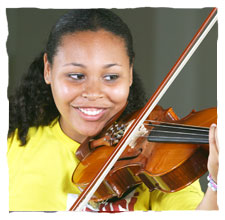 It appeared at about 1500 in Europe, at the same time as the violin. It is very similar to the violin, however it is a bit larger and its sound is deeper and lower. Originally it was associated to a popular environment, used by travelling minstrels. At around 1750, because of the ascension of the urban bourgeoisie, this one and other instruments of the violin family here slowly incorporated into the orchestras. Today, the viola is an instrument of a symphonic orchestra and can be used in many kinds of musical groups.
It appeared at about 1500 in Europe, at the same time as the violin. It is very similar to the violin, however it is a bit larger and its sound is deeper and lower. Originally it was associated to a popular environment, used by travelling minstrels. At around 1750, because of the ascension of the urban bourgeoisie, this one and other instruments of the violin family here slowly incorporated into the orchestras. Today, the viola is an instrument of a symphonic orchestra and can be used in many kinds of musical groups.
Violin
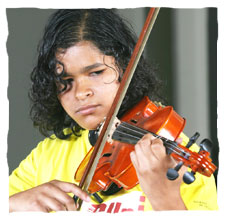 It was developed from a series of pre-baroque instruments. Its current shape came about at around 1600. The first one that we have knowledge of was built by the Italian Luthier Gasparo da Saló. Characterized by its ability to produce acute sounds, the violin was used in Baroque songs mostly in Italy and Germany, but it spread all over Europe. Today it is very present in symphonic or baroque orchestras, in chamber music and also in popular music. It can perform a large variety of musical styles and genres, that makes it an instrument with a huge repertoire.
It was developed from a series of pre-baroque instruments. Its current shape came about at around 1600. The first one that we have knowledge of was built by the Italian Luthier Gasparo da Saló. Characterized by its ability to produce acute sounds, the violin was used in Baroque songs mostly in Italy and Germany, but it spread all over Europe. Today it is very present in symphonic or baroque orchestras, in chamber music and also in popular music. It can perform a large variety of musical styles and genres, that makes it an instrument with a huge repertoire.
Cello
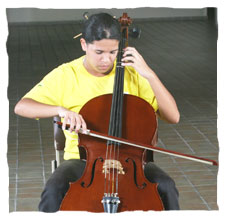 Created during the1600’s in Italy, it is captivating because of the nearness of its sound to the human voice. This makes it all the more used in compositions of diverse musical genres, such as MPB, jazz, soundtracks, regional music and even heavy metal. The Brazilian composer Villa-Lobos created an orchestra for cellos, that exist in the world up to this day. It is an instrument rich in effects, that has an ample variety in timber and tone (variation of the low (deep) and (high). Singers like Tom Jobim, Caetano Veloso and Bob McFerrin produced CDs where the cello was highlighted, with the participation of cello players Yo Yo Ma and Jacques Morelenbaum.
Created during the1600’s in Italy, it is captivating because of the nearness of its sound to the human voice. This makes it all the more used in compositions of diverse musical genres, such as MPB, jazz, soundtracks, regional music and even heavy metal. The Brazilian composer Villa-Lobos created an orchestra for cellos, that exist in the world up to this day. It is an instrument rich in effects, that has an ample variety in timber and tone (variation of the low (deep) and (high). Singers like Tom Jobim, Caetano Veloso and Bob McFerrin produced CDs where the cello was highlighted, with the participation of cello players Yo Yo Ma and Jacques Morelenbaum.
Rabeca
The rabeca was the first musical instrument used in forró, a music genre that originated in Brazil’s Northeast, and there are indications that it has been around since the Middle Ages. The bowed instrument is the precursor of the violin. In Brazil, the rabeca is found from North to South and has been played in popular and religious celebrations since Brazil’s colonial times. The way it is built, tuned and played varies depending on the region from which it comes.
Tuned lower than the violin, it has a twangy timber that is often considered melancholy. Rabecas can have three, four or, very rarely, five strings. The strings can be made of guts or taken from other instruments, such as the cavaquinho, mandolin or acoustic guitar. Tuning varies depending on the player.
Musical Initiation
The Objective of the course of musical initiation is to make the individual more sensitive and receptive to the sound phenomenon, as well as develop his/her musicality. Providing as many varied musical experiences as possible. With a pedagogical leisure component, this course wishes to feed the desire for music. Some of the resources used in the course are singing, dancing, body percussion, small percussion instruments, Orff instrumental (developed for the use of children in a classroom) and the soft flute. The course also wishes to establish the musical foundations needed for later vocal or instrument learning, through practical activities of appreciation, playing and composition, based on the acquisition on elementary technical abilities and literature.
Blowing
Clarinet
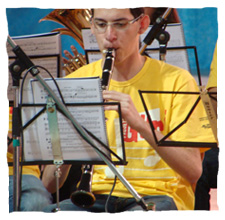 Possibly a descendant of the charamela, a very popular instrument in Europe during the Middle ages, the clarinet was developed and perfected in the 17th and 18th century until it came to its current model. After 1750 it began to be a part of the orchestras. Currently is has been used in contemporary music, folklore and popular music all around the world. It gain popularity with the jazz players Benny Goodman and Artie Shaw and has also been used in military bands. Very versatile, it presents innumerous possibilities of sound due to is long extension, agility and variation of timbres. In Brazil, the clarinet is present in choros, sambas, serestas and MPB.
Possibly a descendant of the charamela, a very popular instrument in Europe during the Middle ages, the clarinet was developed and perfected in the 17th and 18th century until it came to its current model. After 1750 it began to be a part of the orchestras. Currently is has been used in contemporary music, folklore and popular music all around the world. It gain popularity with the jazz players Benny Goodman and Artie Shaw and has also been used in military bands. Very versatile, it presents innumerous possibilities of sound due to is long extension, agility and variation of timbres. In Brazil, the clarinet is present in choros, sambas, serestas and MPB.
Flute
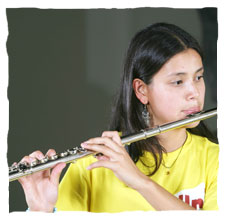 One of the oldest known instruments, it has appeared in may shapes and types ever since the prehistoric period. There are reports of mammoth bone flutes that can be dates back to 30 thousand years. Initially made of rustic material like bamboo, clay and wood, to later be made of metals like silver, some of gold. Because of its versatility, the flute is present in classical, popular and folklore compositions. One of its main characteristics is its fast touch, that allows for the fast execution of sound changes. Its sound may typically be high and sweet, delicate or more potent.
One of the oldest known instruments, it has appeared in may shapes and types ever since the prehistoric period. There are reports of mammoth bone flutes that can be dates back to 30 thousand years. Initially made of rustic material like bamboo, clay and wood, to later be made of metals like silver, some of gold. Because of its versatility, the flute is present in classical, popular and folklore compositions. One of its main characteristics is its fast touch, that allows for the fast execution of sound changes. Its sound may typically be high and sweet, delicate or more potent.
Saxophone
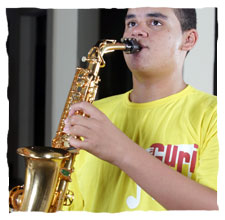
It arose around the 19th century, starting with the need to find an instrument that could create sound balance in the military bands. Contrary to most other instruments, that have origins in bones (flute) or animal horns (trumpet), this one was conceived in 1846 by Adolphe Sax. His invention was incorporated and disseminated to other countries. Although in Europe the Sax is very connected to classical and chamber music, it is not usually a part of orchestral symphonies. In the 20th century, it began to be made in the US and became a symbol of Jazz music. In Brazil, it came at first only to the hands of the religious and the military, and in Rio de Janeiro, our composers made it more Brazilian. Due to its expressiveness and versatility, it can be used in many musical styles and instrumental groups.
Bass tuba
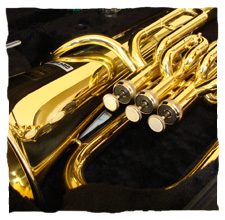 Bass tuba is an instrument that in Portuguese, is known as eufônio, which means ‘to sound good’. The Bass tuba is considered to have appeared in Europe in the 15th century and came to Brazil through the colonization of the Portuguese, and mainly, with the Italian immigrants. Its sound is sweet, velvety and full. It is present in musical bands and religious groups, in orchestras and chamber music groups.
Bass tuba is an instrument that in Portuguese, is known as eufônio, which means ‘to sound good’. The Bass tuba is considered to have appeared in Europe in the 15th century and came to Brazil through the colonization of the Portuguese, and mainly, with the Italian immigrants. Its sound is sweet, velvety and full. It is present in musical bands and religious groups, in orchestras and chamber music groups.
Trombone
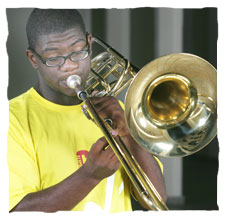 The concrete record that we have of this instrument is after the 16th century, when it was called sackbut, that literally meant push and pull. Ever since, its format has not changed much. Currently the trombone is present in many formations such as orchestra symphonies, bands and big bands. It has a full and robust sound, making it possible for it to interpret melodic musical parts, and if necessary, tempestuous sounds. A very interesting sound effect that it produces is called seglissando, when the musician continues to blow while he moves the rod, sliding from one note to the next.
The concrete record that we have of this instrument is after the 16th century, when it was called sackbut, that literally meant push and pull. Ever since, its format has not changed much. Currently the trombone is present in many formations such as orchestra symphonies, bands and big bands. It has a full and robust sound, making it possible for it to interpret melodic musical parts, and if necessary, tempestuous sounds. A very interesting sound effect that it produces is called seglissando, when the musician continues to blow while he moves the rod, sliding from one note to the next.
Trumpet
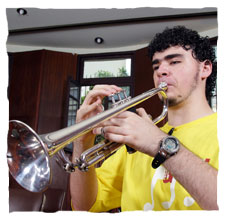 The concrete record that we have of this instrument is after the 16th century, when it was called sackbut, that literally meant push and pull. Ever since, its format has not changed much. Currently the trombone is present in many formations such as orchestra symphonies, bands and big bands. It has a full and robust sound, making it possible for it to interpret melodic musical parts, and if necessary, tempestuous sounds. A very interesting sound effect that it produces is called seglissando, when the musician continues to blow while he moves the rod, sliding from one note to the next.
The concrete record that we have of this instrument is after the 16th century, when it was called sackbut, that literally meant push and pull. Ever since, its format has not changed much. Currently the trombone is present in many formations such as orchestra symphonies, bands and big bands. It has a full and robust sound, making it possible for it to interpret melodic musical parts, and if necessary, tempestuous sounds. A very interesting sound effect that it produces is called seglissando, when the musician continues to blow while he moves the rod, sliding from one note to the next.
Percussion
Within the percussion family there are many instruments that bring many sound possibilities. Some instruments are harmonic and melodic, like the vibraphone and the timpani. Others don’t have notes with a defined sound, which is the case of the tambourine and the triangle.
Many times the repertoire of percussion is able to define nations or regional cultures. When we listen to forró, we remember the northeast. When we listen to samba, we remember Rio de Janeiro, and so on and so forth. And what’s more interesting: the instruments have a diversified use in the most varied formations and are present in orchestras, traditional groups, drums and schools of samba, capoeira circles and much more.
Keys
Keyboard/ Piano
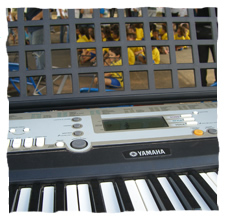 The keyboard course intends to develop specific abilities for play songs on the keyboard or the piano, through the activities proposed by Maria de Lourdes Junqueira Gonçalves and Cacilda Borges Barbosa in the volumes of the book Educação musical através do teclado – Musical Education through the Keyboard. It also intends to develop abilities of critical listening, interpretation and creativity, through pedagogical leisure activities based on the (T)EC(L)A model , from Keith Swanwick.
The keyboard course intends to develop specific abilities for play songs on the keyboard or the piano, through the activities proposed by Maria de Lourdes Junqueira Gonçalves and Cacilda Borges Barbosa in the volumes of the book Educação musical através do teclado – Musical Education through the Keyboard. It also intends to develop abilities of critical listening, interpretation and creativity, through pedagogical leisure activities based on the (T)EC(L)A model , from Keith Swanwick.
Accordion
The accordion was invented in 1822 by a German man named Friedrich Buschmann. In June 19, 1829, Charles Wheatstone organized, in London, the first concert to use the instrument. The instrument was brought to Brazil by German immigrants around 1836, arriving first in the state of Rio Grande do Sul in the country’s South. In the second half of the 1860s, the instrument arrived in Brazil’s North. The accordion was immediately popular and became a status symbol.
Today, there are three basic types of accordion: piano accordions (with keys), button accordions and the bandoneon (slightly larger than button accordions). The Projeto Guri provides 80-bass piano accordions to students studying the instrument. Classes have been offered for the last three years at the Regional Centers in Presidente Prudente, Caiabu, Palmital and Barretos.
Accordion classes seek to promote the development of music composition, execution and appreciation skills through activities focused on developing the human dimension of each student. Through this complete instrument, students can express themselves musically in a memorable and enjoyable, with classes organized in groups of five students.

